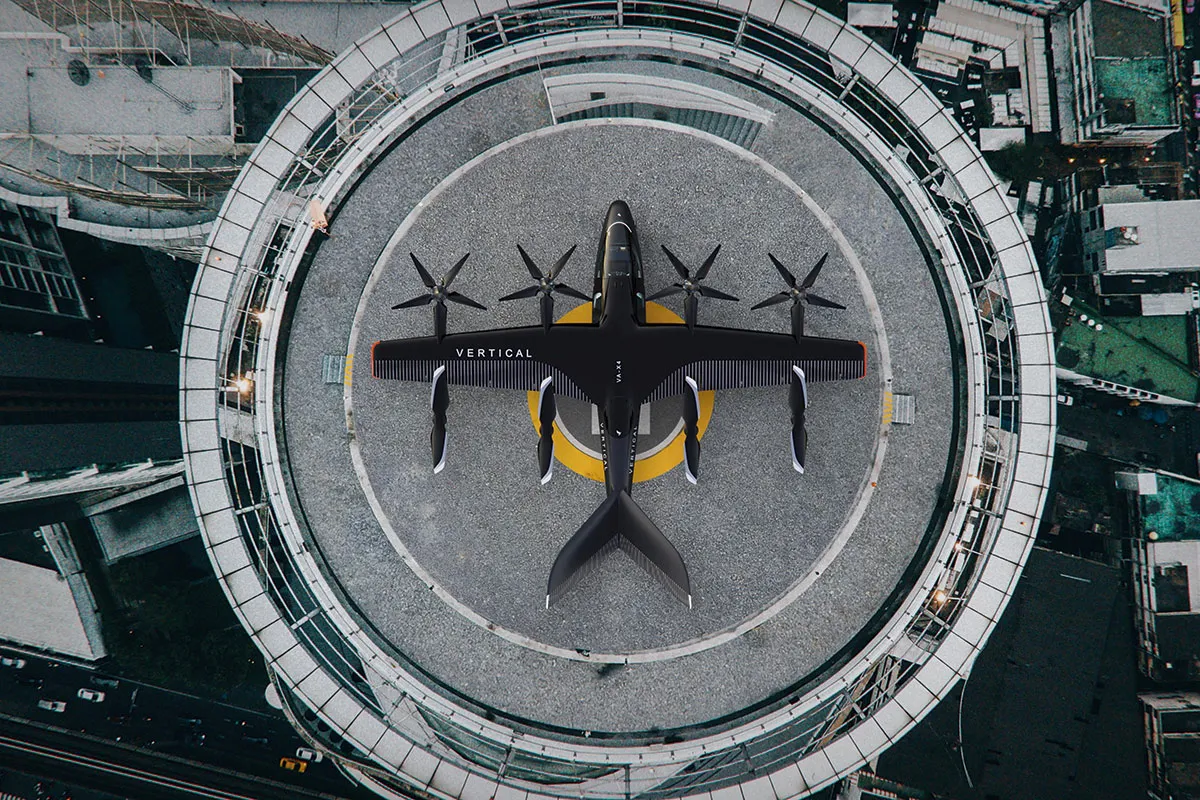It’s hard to decide whether flying taxis are arriving very late or extremely early. On the one hand, the promise of airborne cabs zipping between skyscrapers has been a science fiction staple for decades. On the other, it wasn’t long ago that air taxis were filed in the ‘we’ll see’ folder of future technology, alongside hoverboards and hotels on the Moon.
But after years of wishful thinking, it’s suddenly happening. Investment in advanced aerial mobility (as the sector is known) has more than tripled in the last year, and analysts at Morgan Stanley expect the global air taxi market to be worth £2.7tr by 2050.
Early or late, the future is en-route and will be coming in to land sooner than the majority of people realise. A number of companies around the world are currently preparing eVTOL vehicles (electric vertical take-off and landing vehicles), which could revolutionise the way we get around big cities.
Quiet, comfortable and carbon-free, eVTOLs promise to rise above congested roads, easing urban transport issues while getting passengers to their destinations in record time. Meanwhile, regulators on the ground are working hard to prepare the rules and infrastructure required to make this new form of transport feasible.
Read more about air taxis:
- World’s first urban airport for drones and flying taxis to open in Coventry
- Inside the world’s first airport for drones and flying cars
Air taxis
Many developers believe their vehicles will be safety certified and cleared for take off by 2025, if not sooner. Boeing, Airbus and Hyundai are some of the familiar names building air taxis. Another is Joby, which bought Uber Elevate, the ride-sharing giant’s foray into eVTOLs, in December 2020. Meanwhile, British firm Vertical claims to have the highest number of conditional pre-orders with the likes of Virgin Atlantic and American Airlines among the investors lining up for its VA-X4 vehicle.
“It’s going to be a quiet and pleasant, fast and efficient way of getting around,” says Andrew Macmillan, director of infrastructure at Vertical. “[The VA-X4] allows you to travel 100-plus miles [160km] at 200mph [322km/h]. It takes off vertically and then transitions to fly horizontally, giving you that range.”
The VA-X4 will carry four passengers and a pilot. In the rear, two pairs of people will sit facing each other like in the back of a London taxi. As a fare-payer, you can look out of the windows and chat with your fellow flyers without the need for ear protection or microphones. That’s because, like the majority of eVTOLS, the VA-X4 flies using quiet electric rotors that, per journey, produce less carbon than a Tesla travelling the same distance on the roads below.
Air taxis are not exactly the flying cars promised by The Jetsons, Blade Runner and Back To The Future, however. Rather, it’s electrified air travel scaled down to black cab proportions. It’s Uber for the skies. Think helicopters without the emissions or the reliance on one main rotor.
“Helicopters are amazing machines, but they’re quite noisy, they’re very expensive and they’re quite dangerous as well,” Macmillan says. “One of the reasons the VA-X4 is safe is that you’ve got eight rotors, all electric powered, and each of them has a separate motor. If you lose one, you don’t lose the vehicle.”
If eVTOLs are revolutionary in what they might do for urban transport, they’re more evolutionary in terms of the underlying technology. Electric propulsion, super-efficient batteries and lightweight composites underpin air taxi design and all of it comes from technologies being developed in tandem sectors.
“I think we’ve been able to reap some of the benefits of what’s been happening on the surface side of electric propulsion,” says Clint Harper, urban air mobility fellow at Urban Movement Labs, a non-profit designed to help facilitate future transport solutions in Los Angeles. “The overall design of the aircraft, how they fly, how they stay in the air, you know, we’re building off lessons that have been learnt over the last century of air travel.”
The point is that eVTOLs are not flying cars at all. “This is, in fact, aviation – the next evolution of it: a quieter, cleaner, more sustainable aviation,” says Harper’s colleague, Sam Morrissey, executive director of Urban Movement Labs. “Once we reframe it back to aviation, I think people understand how and why we’re going to see these new vehicles and this new technology as quickly as we’re going to.”
Integrating air taxis into cities

Urban Movement Labs is helping the city of Los Angeles prepare for the advent of eVTOLs. The famously horizontal city grew by sprawl and its freeways are known for traffic jams. Morrissey believes advanced air mobility could ease the problems on the ground and “make travel happen in a way that’s not [currently] physically possible.”
His example is travelling from downtown Los Angeles to Santa Monica, 15 miles [24km] away. “It’s physically impossible to make that trip in under 30 minutes. But, say my child was in a hospital in Santa Monica, with this new technology I could make that journey in minutes.”
Los Angeles isn’t the only place that’s preparing for flying taxis. São Paulo, Osaka and Singapore are some of the sprawling, densely populated, global cities at various stages of planning for advanced air mobility. Closer to home, Europe’s first ‘vertiport’ – the name for eVTOL landing sites – is being built in France in time for the 2024 Paris Olympics. Vertiports have also been proposed for the UK, where a number of intercity eVTOL routes have already been planned.
Imagine travelling cross-country from Liverpool to Hull, or flying over water from South Wales to Cornwall, or Belfast to Glasgow. Even a seemingly pedestrian journey from Heathrow Airport to Cambridge takestwo hours or more by car or train. You could do it in 20 minutes in an air taxi.
In order for those journeys to become a reality, however, much more planning and infrastructure is required. eVTOLs may plug into existing air traffic control structures and communication frequencies, but regulators will need to develop new licensing and credentials standards. There’s also the rather pressing question of where exactly air taxis will land and take off from.
Initially, they are likely to fly to and from existing airports and helipads, but they’ll very soon need their own spaces within our cities, explains Harper. “Once we talk about integrating those into the urban fabric of the neighbourhoods or communities, there’s a lot of things to think of,” he adds. “It’s going to take dedicated infrastructure, which includes recharging these vehicles, maintenance and servicing, and storing them overnight.”
In science fiction, flying cars often dock on skyscrapers, but that’s unlikely to be practical in the real world. Would you want to climb to the top floor of a tall building just to catch a taxi? Morrissey believes vertiports could instead be built on top of, or alongside, existing transport hubs so that passengers can connect from one mode to another. “We see this as integrating with the existing bus, rail and transit networks in places that are truly multimodal hubs,” he says.
Planning is vital. In the past, new transportation technologies have come along and surprised society. “The steam locomotive was created and we had to build tracks and railroads. The bicycle and the internal combustion engine were invented and we had to build roads,” says Morrissey. Even today’s electric scooters caught governments and city planners napping, with the vehicles hitting roads before rules were drawn up to govern their usage.
There is reason to believe that advanced aerial mobility will be different, however. There is a (metaphorical) runway between now and the vehicles’ launch, during which planners have time to work out how, where and why eVTOLs should fly. “I think, for the very first time in human history, we’re able to develop a transportation system to serve a new mode of transportation before that mode of transportation exists,” says Morrissey.
As well as flying taxis, eVTOLs could be used for search and rescue, transporting organs for transplant, as well as delivery and tourism. Estimates vary, but we could see hundreds or even thousands of them in the skies above the UK in the coming decades, with remotely piloted or even automated vehicles coming in time. However many there are, experts now agree that it’s not a case of if, but when the technology will arrive.
“Safety certification is the tipping point,” says Macmillan. “Once you start seeing that happen, then you know it’s real because you’ll just see them flying through the air.”
- This article first appeared inissue 373ofBBC Science Focus Magazine–find out how to subscribe here
Read more about the future of transport:
- Future cars: 9 designs that could revolutionise the vehicle industry
- In pictures: X-59 QueSST, the supersonic aircraft that doesn't go boom
- Rolls-Royce claims its all-electric plane is the fastest ever made
Browse:

